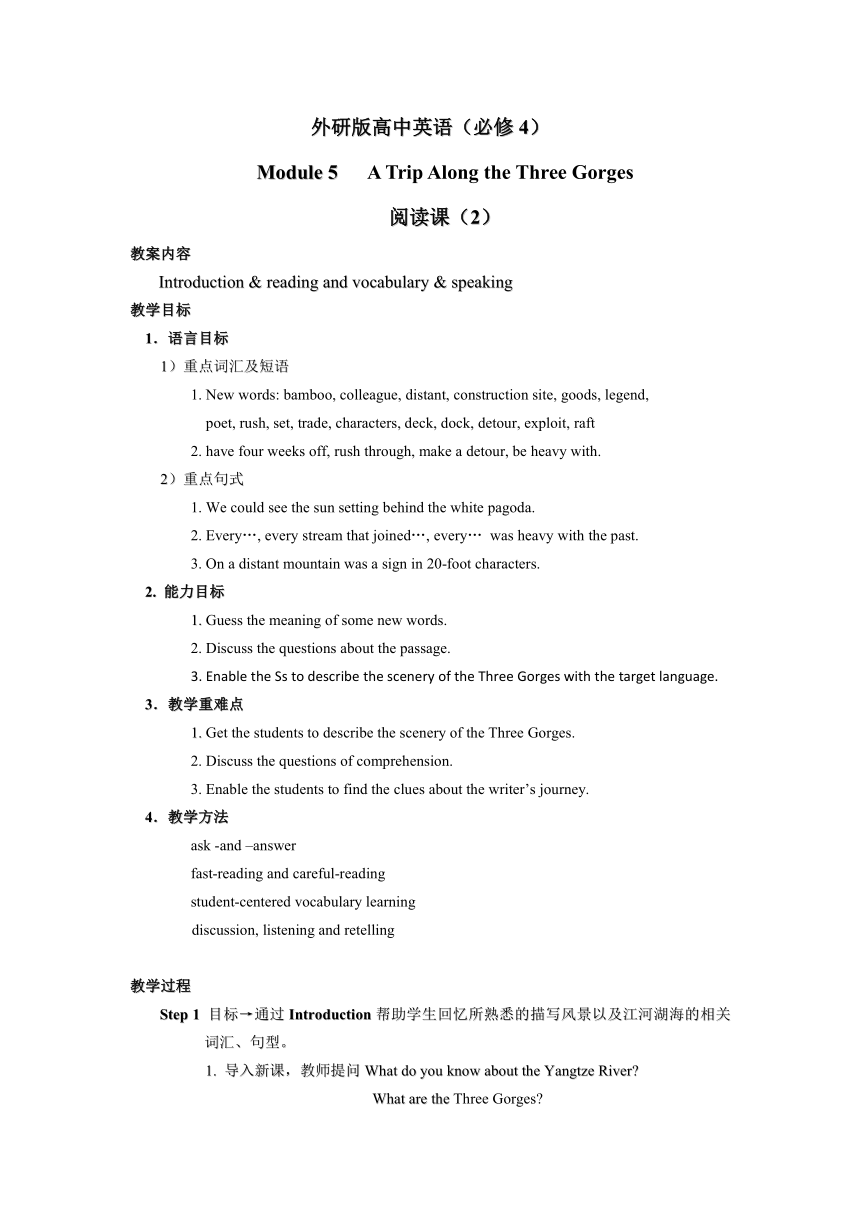Module 5 A Trip Along the Three Gorges教案
文档属性
| 名称 | Module 5 A Trip Along the Three Gorges教案 |

|
|
| 格式 | zip | ||
| 文件大小 | 15.6KB | ||
| 资源类型 | 教案 | ||
| 版本资源 | 外研版 | ||
| 科目 | 英语 | ||
| 更新时间 | 2013-03-02 18:52:32 | ||
图片预览

文档简介
外研版高中英语(必修4)
Module 5 A Trip Along the Three Gorges
阅读课(2)
教案内容
Introduction & reading and vocabulary & speaking
教学目标
1.语言目标
1)重点词汇及短语
1.?New?words:?bamboo,?colleague,?distant,?construction?site,?goods,?legend,
poet,?rush,?set,?trade,?characters,?deck,?dock,?detour,?exploit,?raft
2. have four weeks off, rush through, make a detour, be heavy with.
2)重点句式
1. We could see the sun setting behind the white pagoda.
2. Every…, every stream that joined…, every… was heavy with the past.
3. On a distant mountain was a sign in 20-foot characters.
2. 能力目标
1. Guess the meaning of some new words.
2. Discuss the questions about the passage.
3. Enable the Ss to describe the scenery of the Three Gorges with the target language.
3.教学重难点
1. Get the students to describe the scenery of the Three Gorges.
2. Discuss the questions of comprehension.
3. Enable the students to find the clues about the writer’s journey.
4.教学方法
ask -and –answer
fast-reading and careful-reading
student-centered vocabulary learning
discussion, listening and retelling
教学过程
Step 1 目标→通过Introduction帮助学生回忆所熟悉的描写风景以及江河湖海的相关词汇、句型。
1. 导入新课,教师提问What do you know about the Yangtze River?
What are the Three Gorges?
学生展开讨论,自由发言,介绍长江,走进长江。并完成Introduction 的相关练习。
2. 引出本课重点,展示三峡沿途精美图片,文物古迹,人物传奇等,结合图片,给学生以直观的感受,让他们进一步了解长江,畅谈长江。开阔眼界,拓展文化领域,陶冶情操。
3. 讲解一些重点词汇:character, deck, dock, detour, exploit, pagoda, raft
Step 2 目标→引入阅读主题,完成阅读任务,锻炼学生的速度和概括能力。
听录音,快速阅读,归纳出关于游记文章的时间,地点,人物,事件,过程等五要素。
回答问题,锻炼学生搜索信息,捕捉信息的能力,目的在于锻炼学生快速阅读的能力。
Read para.2-5 and answer questions
What was the weather like when they left?
What were they doing when they passed the Qutang Gorge?
What is special with the Xiang River?
Peter was impressed by the Yangtze River’s sense of_____.
a. power b. history c. danger
小组讨论,各个段落的主旨大意,在课堂上用简要的话概括五段的大意,培养学生的综合概述能力。
图表归纳:
A Trip Along the Three Gorges
Time
Place
Character
Event
In January 1997
The Three Gorges
Peter Hessler and a colleague
Taking a boat downstream
Processes
Para. 1
Buying tickets for the Jiangyou boat
Para. 2
Leaving the docks on a beautiful afternoon
Para. 3
Sleep throught the first gorge called the Qutang Gorge
Para. 4
At Wushan making a detour up the Daning River to see some of the smaller gorges
Para. 5
Sailing into the construction site of the Three Gorges Dam
Step 3目标→精读文章,讲解重点,难点,完成阅读训练。
整理出本课的重点词汇和短语:
1)New?words:?bamboo,?colleague,?distant,?construction?site,?goods,?legend,
poet,?rush,?set,?trade,?characters,?deck,?dock,?detour,?exploit,?raft
2)have four weeks off, rush through, make a detour, be heavy with
2. 重点讲解1)We could see the sun setting behind the white pagoda.句式。(总结see, watch , hear, listen to等词后接sb.+doing 的用法)
2)On a distant mountain was a sign in 20-foot characters.句式。(介词短语放在句首,符合完全倒装)
3. 完成文后相关习题,检查核对答案。
Step 4目标→口语训练。
1. 鼓励每一位学生描述自己曾经游记过的某个地方,所见所闻及自己的真实感受。
2. 小组活动,引导学生概括以上所学游记的五要素。时间,地点,人物,事件,过程。
3. 小组交流,向其他同学推荐自己曾经去过的某处风景。
Step 5 总结和作业。
听读复述课文。
完成练习册相关练习。
课后反思:
本课主要训练学生的阅读搜取信息的能力,通过图片展示,阅读,精读,了解文章的脉络,通过填写表格的形式使学生能够复述游程的线路,每一段落的主旨大意,三峡的具体特征特点,锻炼学生的理解与概括能力。口语训练,锻炼学生对游记文章五要素的把握以及描述某处风景的所见所闻,和他们游历时的真实感受。通过本课的学习,学生基本掌握有关词汇,短语,练习游记文章的描述。更重要的是培养了学生描述某处风景的写作能力。
教学点评:
教师在本节阅读课中精心设计课堂教学的各个环节。形式多样,由浅入深,能吸引学生的注意,让学生“活”起来,促进学生主动参与,积极思考,认真实践,从而促进学生的整体素质的提高。
在阅读训练中,老师注重阅读方法和阅读技巧的渗透和培养,帮助学生快速获取和筛选有用的信息。通过讨论分析促使学生实现对文章的深刻理解。
从整节课的教学过程可以看到,教师是针对自己学生的实际情况认真设计的。注重对学生基础知识的巩固和落实。语言输入的目的在于语言输出,让学生练习游记文章的描述培养了学生的表达能力。
Module 5 A Trip Along the Three Gorges
阅读课(2)
教案内容
Introduction & reading and vocabulary & speaking
教学目标
1.语言目标
1)重点词汇及短语
1.?New?words:?bamboo,?colleague,?distant,?construction?site,?goods,?legend,
poet,?rush,?set,?trade,?characters,?deck,?dock,?detour,?exploit,?raft
2. have four weeks off, rush through, make a detour, be heavy with.
2)重点句式
1. We could see the sun setting behind the white pagoda.
2. Every…, every stream that joined…, every… was heavy with the past.
3. On a distant mountain was a sign in 20-foot characters.
2. 能力目标
1. Guess the meaning of some new words.
2. Discuss the questions about the passage.
3. Enable the Ss to describe the scenery of the Three Gorges with the target language.
3.教学重难点
1. Get the students to describe the scenery of the Three Gorges.
2. Discuss the questions of comprehension.
3. Enable the students to find the clues about the writer’s journey.
4.教学方法
ask -and –answer
fast-reading and careful-reading
student-centered vocabulary learning
discussion, listening and retelling
教学过程
Step 1 目标→通过Introduction帮助学生回忆所熟悉的描写风景以及江河湖海的相关词汇、句型。
1. 导入新课,教师提问What do you know about the Yangtze River?
What are the Three Gorges?
学生展开讨论,自由发言,介绍长江,走进长江。并完成Introduction 的相关练习。
2. 引出本课重点,展示三峡沿途精美图片,文物古迹,人物传奇等,结合图片,给学生以直观的感受,让他们进一步了解长江,畅谈长江。开阔眼界,拓展文化领域,陶冶情操。
3. 讲解一些重点词汇:character, deck, dock, detour, exploit, pagoda, raft
Step 2 目标→引入阅读主题,完成阅读任务,锻炼学生的速度和概括能力。
听录音,快速阅读,归纳出关于游记文章的时间,地点,人物,事件,过程等五要素。
回答问题,锻炼学生搜索信息,捕捉信息的能力,目的在于锻炼学生快速阅读的能力。
Read para.2-5 and answer questions
What was the weather like when they left?
What were they doing when they passed the Qutang Gorge?
What is special with the Xiang River?
Peter was impressed by the Yangtze River’s sense of_____.
a. power b. history c. danger
小组讨论,各个段落的主旨大意,在课堂上用简要的话概括五段的大意,培养学生的综合概述能力。
图表归纳:
A Trip Along the Three Gorges
Time
Place
Character
Event
In January 1997
The Three Gorges
Peter Hessler and a colleague
Taking a boat downstream
Processes
Para. 1
Buying tickets for the Jiangyou boat
Para. 2
Leaving the docks on a beautiful afternoon
Para. 3
Sleep throught the first gorge called the Qutang Gorge
Para. 4
At Wushan making a detour up the Daning River to see some of the smaller gorges
Para. 5
Sailing into the construction site of the Three Gorges Dam
Step 3目标→精读文章,讲解重点,难点,完成阅读训练。
整理出本课的重点词汇和短语:
1)New?words:?bamboo,?colleague,?distant,?construction?site,?goods,?legend,
poet,?rush,?set,?trade,?characters,?deck,?dock,?detour,?exploit,?raft
2)have four weeks off, rush through, make a detour, be heavy with
2. 重点讲解1)We could see the sun setting behind the white pagoda.句式。(总结see, watch , hear, listen to等词后接sb.+doing 的用法)
2)On a distant mountain was a sign in 20-foot characters.句式。(介词短语放在句首,符合完全倒装)
3. 完成文后相关习题,检查核对答案。
Step 4目标→口语训练。
1. 鼓励每一位学生描述自己曾经游记过的某个地方,所见所闻及自己的真实感受。
2. 小组活动,引导学生概括以上所学游记的五要素。时间,地点,人物,事件,过程。
3. 小组交流,向其他同学推荐自己曾经去过的某处风景。
Step 5 总结和作业。
听读复述课文。
完成练习册相关练习。
课后反思:
本课主要训练学生的阅读搜取信息的能力,通过图片展示,阅读,精读,了解文章的脉络,通过填写表格的形式使学生能够复述游程的线路,每一段落的主旨大意,三峡的具体特征特点,锻炼学生的理解与概括能力。口语训练,锻炼学生对游记文章五要素的把握以及描述某处风景的所见所闻,和他们游历时的真实感受。通过本课的学习,学生基本掌握有关词汇,短语,练习游记文章的描述。更重要的是培养了学生描述某处风景的写作能力。
教学点评:
教师在本节阅读课中精心设计课堂教学的各个环节。形式多样,由浅入深,能吸引学生的注意,让学生“活”起来,促进学生主动参与,积极思考,认真实践,从而促进学生的整体素质的提高。
在阅读训练中,老师注重阅读方法和阅读技巧的渗透和培养,帮助学生快速获取和筛选有用的信息。通过讨论分析促使学生实现对文章的深刻理解。
从整节课的教学过程可以看到,教师是针对自己学生的实际情况认真设计的。注重对学生基础知识的巩固和落实。语言输入的目的在于语言输出,让学生练习游记文章的描述培养了学生的表达能力。
